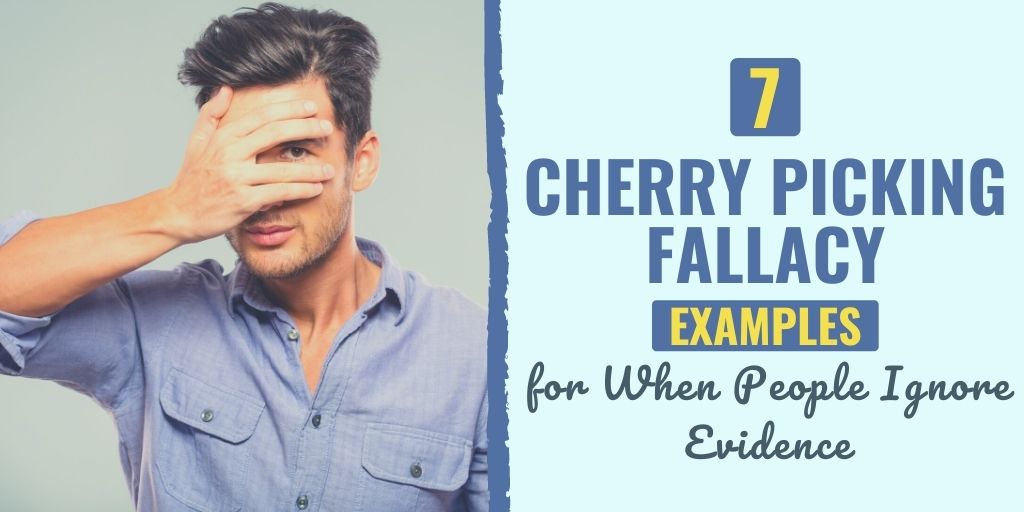There might be affiliate links on this page, which means we get a small commission of anything you buy. As an Amazon Associate we earn from qualifying purchases. Please do your own research before making any online purchase.
When I was in high school, I had to participate in a debate with a classmate on the topic of whether or not the drinking age should be pushed from 21 to 18.
I was assigned to argue that it should be 18 and she argued that it should stay 21.
I initially thought this task would be easy, but I found that there was very little evidence out there to support my claim.
So what did I do?
I picked the two or three articles that had even one sentence that could be interpreted in my favor and I ran with them. I ignored the rest of the information I came across (which was a lot) that argued against my claim, and only paid attention to confirming evidence.
This practice of “cherry picking” is common when looking for evidence to support an argument, and you’ve probably resorted to it yourself. In this article, we will look at an in-depth definition of the cherry picking fallacy as well as 7 examples of this logical fallacy that you could come across in your everyday life.
Let’s get started.
What is the Cherry Picking Fallacy?
Cherry picking is a logical fallacy that happens when someone focuses solely on evidence that supports their position on a claim and ignores any information that goes against their defense.
For example, someone engaging in cherry picking might reference only a few studies published on a certain topic in an effort to make it appear that science supports their stance. In this case, cherry picking is done intentionally, taking advantage of its persuasive rhetorical value to convince someone of something.
And, while doing this could lead to backlash if the omission of data is discovered, the power of using this technique usually outweighs any risk, especially when people aren’t likely to go out and do their own research on a topic. People often use this logical fallacy to appear to be more credible in their field than they may actually be.
Cherry picking can also be done unintentionally, which occurs most frequently when people resort to confirmation bias, where they favor information that confirms their beliefs. Because people prefer to feel like they’re correct in their thinking, when they come across new information, they “cherry pick” anything that confirms their current beliefs and ignore any contradictory information.
People may also engage in unintentional cherry picking when handling just a few bits of information is easier than sorting through all of the information that’s available on a topic. When faced with a vast amount of evidence, it’s tempting to simplify the data down to a few points that stick out of the bunch and focus solely on those rather than taking the time to carefully analyze all of the information.
The term “cherry picking” came from the process of picking fruit, such as cherries. When doing this, only the ripest cherries that are in the best condition are picked, which can lead an onlooker to assume that all of the cherries available to be picked are in such a great condition.
Cherry picking often takes the following form:
Often, arguments that are cherry picked give the impression that the data referenced is representative of the whole, when it’s actually the exception to the rule. Because of this, a lot of cherry picking evidence is anecdotal because it relies on one or two examples to try to prove a point.
This logical fallacy is important to understand because it can lead people to present (or believe) misleading information. Even though the data presented may be valid, it’s often being misused to represent a larger portion of the truth than is accurate. When only pointing to the unique data that confirms a certain position and ignoring the significant amount of cases that contradict the position, the speaker is using a logical fallacy that is similar to what we have seen when looking at confirmation bias.
It’s important to remember that high-quality data is just one element of a strong argument, as the integrity of the analysis of that data in addition to how it is presented are also critical to making a sound argument.
Cherry picking is frequently used in a variety of everyday domains, and can influence how people communicate information and how information is received by a listener. Let’s take a look at some examples of how this logical fallacy is used.
7 Cherry Picking Fallacy Examples for When People Ignore Evidence
1. In Politics
Politicians often cherry-pick information when trying to back up their stance on an issue that could impact our country. For example, politicians frequently refer to the success (or failure) of policies that have been adopted in other countries when they’re trying to convince people that America either should or should not implement the policy as well.
When backing up their argument, politicians will pick and choose which data points they will bring up to sway people into agreeing with their opinion on the policy. They will also use anecdotal evidence that sounds very convincing, but can be the exception to the rule or have negative consequences that the politician fails to mention.
However, because people don’t often do their own independent research on these things after hearing an argument of this type, they can become convinced of something that isn’t objectively true.
2. Advertising
There was a commercial out several years ago that stated “4 out of 5 dentists” agreed that a certain product was beneficial for oral health. What the commercial didn't state was the method they used for gathering their sample of dentists to learn their opinions or the total number of dentists who were surveyed.
This means that the advertisers behind the product could have asked only 5 dentists, four of which they knew would support their product.
Without any further information on the people whose opinions were gathered, one may assume that the subjects of this study were picked intentionally to favor the opinion of those gathering the research. However, the statement sounds convincing if it isn’t given any further thought.
3. “Our new elementary educational program was a success because it improved students’ reading scores.”
This statement could be made by someone who created a new program for childhood education and is trying to sell it to other schools. However, this claim would be considered to be cherry picking if the new program also decreased students’ math and science skills. It could also be considered to be cherry picking if the program only showed an improvement in 8 students’ reading scores when 40 students were being monitored.

Saying that a program improved students’ reading scores doesn’t show a comprehensive overview of the results of the program. It potentially only represents a small sample of students and would therefore not be beneficial for other schools to adopt.
4. Media
Yahoo recently faced some backlash for publishing an article titled, “Chris Pratt criticized for ‘white supremacist’ T-shirt” after the actor was spotted wearing a shirt portraying a version of the Gadsden flag. Yahoo pinpointed some comments on social media that linked this symbol to far-right groups and white supremacy ideologies, and noted that the Gadsden flag, which was created by American Revolutionary war general, Christopher Gadsden, portrays a racially-charged message.
However, while some social media posts did criticize Chris Pratt for wearing this shirt, many recognized that the flag originated in a non-racial context and therefore did not accuse Pratt of being racist.
Yahoo later changed the name of the article after being called out for cherry picking some online commenters and turning their opinions into a click-bait headline.
5. News
Cherry picking can be found in the news, especially when reading sources that aren’t very reputable. This happens when journalists only tell one side of a story and ignore facts that support different viewpoints. For example, let’s say a journalist is reporting on a recent study that asked the opinion of 4,000 doctors on the efficacy of a new drug treatment for cancer. In this study, the researchers found that 99% of the doctors they interviewed believed the new drug showed promising results in the treatment of cancer.
However, when reporting on this study, a cherry-picking journalist may argue that there are plenty of doctors who think that the new drug is not promising, referring to the 40 doctors who were in the vast minority of the entire group. The reporter is only referring to the few doctors who do not agree with the consensus opinion on the drug in question.
And, while it’s possible for a consensus position to be wrong, the issue with cherry picking here isn’t that it goes against the majority, but rather that it makes a misleading argument to support the opposite claim by ignoring most (or all) of the evidence in the claim’s favor.
6. Research
Cherry picking can impact how people think and therefore how people do research in the scientific community. For example, one issue that has been known to be problematic in research is creating a hypothesis after the cause of a phenomenon is already known. In this situation, people sort through information looking specifically for data, samples, and interpretations that give strong potential support for their hypothesis, even though doing this negates the validity of the research.
This phenomenon has been found to be true in many cases, which can ultimately impact the results of systematic reviews of studies. Ignoring contradictory evidence to a main hypothesis in the scientific community has been equated to sweeping inconvenient facts under the rug to make a simple interpretation of a complex reality.
7. Surveys
Let’s say a survey was sent out to participants who had completed a workout program to get their feedback on their experience and results. However, those who didn’t complete the entire program were not given the survey. Generally, those who didn’t see any results during the program dropped out before it was complete, as payments for the program were taken on a weekly basis and those who felt they weren’t getting their money’s worth didn’t want to pay anymore to continue.

This means that the surveys collected very positive results because only the people who achieved their goals in the program and continued to show progress completed it and were then offered a survey to fill out. These participants were cherry picked to give their feedback, which skewed any final report on the efficacy of the workout program.
How to Respond to this Fallacious Argument and Avoid Using it Yourself
There are two ways to respond to cherry picking, you can either point out the fact that information is being omitted from an argument or you can bring that omitted information into the conversation yourself. However, it’s important to remember that a person may engage in cherry picking unintentionally, so it’s best to not accuse them of trying to be deceptive.
This means it’s best to ask the other person to explain their omission of crucial information instead of attacking them for a potential mistake. This will also increase the other person’s willingness to listen to your side of the argument, and therefore more likely to absorb the information you’re giving them.
And, because you can engage in cherry picking without meaning to do so, you need to be careful to avoid doing this unintentionally. The best way to do this is to ask yourself if there’s any additional evidence that you should consider when making an argument. If there is, you should try to modify your argument by including this additional information.
To help you with this, use techniques such as avoiding making a hypothesis before you’ve had an opportunity to review all of the available information. You can also take your time when reasoning through an argument, which will also reduce the chance that you will cherry pick information.
Final Thoughts on the Cherry Picking Logical Fallacy
As always, if you find yourself facing this fallacy in your everyday life, it’s important to recognize that the argument should be rejected because it isn’t coupled with sound reasoning. And, if you find yourself cherry picking information for one of your own arguments, think back to this article and remember that any listeners who are thinking logically will not see you as being a credible resource.
Take these examples into consideration in your own life and think about how you may have fallen victim to this logical fallacy in the past so you can avoid doing so in the future.
Other Logical Fallacies and Their Examples
- 5 Appeal to Nature Fallacy Examples in Media and Life
- 6 Outcome Bias Examples That Can Negatively Impact Your Decisions
- 7 Self-Serving Bias Examples You See Throughout Life
- 7 Self-Serving Bias Examples You See Throughout Life
- 7 Omission Bias Examples That Negatively Impact Your Life
- 6 Authority Bias Examples That Might Impact Your Decisions
- 5 Burden of Proof Fallacy Examples
- 5 Appeal to Tradition Fallacy Examples in Life
- 5 Appeal to Authority Logical Fallacy Examples
- 7 False Cause Fallacy Examples
- 7 Appeal to Ignorance Fallacy Examples
- 7 Appeal to Common Sense Logical Fallacy Examples
- 5 Post Hoc Fallacy Examples (and How to Respond to This Argument)
- Gambler’s Fallacy: 5 Examples and How to Avoid It
- 5 Appeal to Anger Fallacy Examples Throughout Life
- 7 Halo Effect Bias Examples in Your Daily Life
- 7 Poisoning the Well Examples Throughout Your Life
- 7 Survivorship Bias Examples You See in the Real World
- 7 Dunning Kruger Effect Examples in Your Life
- 7 Either Or (“False Dilemma”) Fallacy Examples in Real Life
- 5 Cui Bono Fallacy Examples to Find Out “Who Will Benefit”
- 6 Anchoring Bias Examples That Impact Your Decisions
- 7 Virtue Signaling Examples in Everyday Life
- 9 Circular Reasoning Examples (or “Begging the Question”) in Everyday Life
- 9 Appeal to Emotion Logical Fallacy Examples
- 9 Appeal to Pity Fallacy (“Ad Misericordiam”) Examples in Everyday Life
- 9 Loaded Question Fallacy Examples in Life and Media
- 9 Bandwagon Fallacy Examples to Prevent Poor Decisions
- 5 Red Herring Fallacy Examples to Fight Irrelevant Information
- 9 Middle Ground Fallacy Examples to Spot During an Argument
- 5 False Equivalence Examples to Know Before Your Next Argument
- 7 Hasty Generalization Fallacy Examples & How to Respond to Them
- 6 Straw Man Fallacy Examples & How You Can Respond
- 6 False Dichotomy Examples & How to Counter Them
- 7 Slippery Slope Fallacy Examples (And How to Counter Them)
- What is the Planning Fallacy?
- How to Overcome the “Sunk Cost Fallacy” Mindset
Finally, if you want a simple process to counter the logical fallacies and cognitive biases you encounter in life, then follow this 7-step process to develop the critical thinking skills habit.

Connie Mathers is a professional editor and freelance writer. She holds a Bachelor's Degree in Marketing and a Master’s Degree in Social Work. When she is not writing, Connie is either spending time with her daughter and two dogs, running, or working at her full-time job as a social worker in Richmond, VA.


